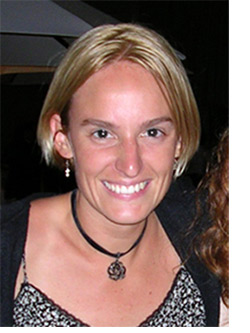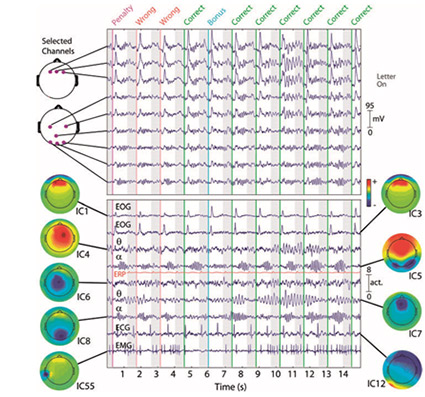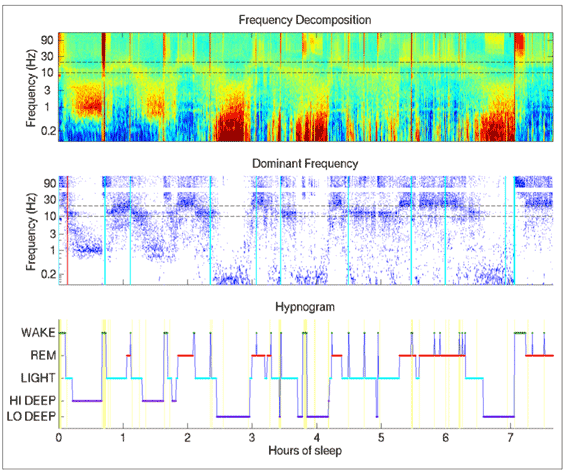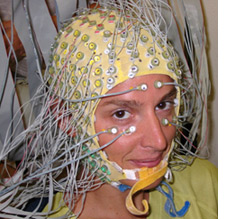The EEGLAB News #3
 Julie Onton, Ph.D.
Julie Onton, Ph.D.
Associate Project Scientist,
Swartz Center for Neural Computation (SCCN)
within the Institute for Neural Computation (INC), at UC San Diego
It’s amazing how a single moment in time can shape your life. Dr. Julie Onton experienced one of those moments as a freshman at UC Berkeley. While reading a Scientific American issue on The Mind and the Brain, she recalls, “I came across an article about schizophrenia that particularly interested me because my brother has been diagnosed with schizophrenia. I remember asking myself, 'Why does his brain work so differently from mine?' And that was the beginning of the rest of my life … I was hooked!”
Dr. Onton decided to devote her future to studying the brain. She wasted no time working towards her goal, graduating from Berkeley with a bachelor’s degree in neurobiology in 1996, and then earning a Ph.D. in neuroscience from Tufts University in 2001. After learning about neurofeedback*, she “quickly got sucked into an intense fascination with the electrical signals that emanate from the brain.” She clarifies: “I was especially interested in the oscillations that changed speed and amplitude depending on behavior or internal state. Maybe it’s because I was introduced through neurofeedback, but these oscillations seemed so mysterious and special. They still do…”
That sense of inscrutability and awe about brain waves continues to drive her research. She explains: “The main frequency bands researchers look at are in the delta (1-3 Hz), theta (4-8 Hz), alpha (8-12 Hz) and beta (~12-30 Hz) ranges. Certain frequencies are tied to certain activities. For example, delta is mostly discussed in the context of sleep. Concentration elicits theta, and alpha jumps up when you close your eyes. It seems sort of cut and dried sometimes when you read papers.” She pauses, emphasizing the mystery of it all: “But then when you look at single trials, you find that the average activity does not occur on every trial, which begs the question, ‘How did they accomplish the task on this trial when the activity looks nothing like the average?’ Clearly there is more to know. For example, what does it really mean that theta amplitude increases? How does that synchrony occur and how exactly does that accomplish the goal? We only understand broad strokes right now.” She takes a moment, then jokes, “I kind of think understanding the brain might be beyond our comprehension!”
That’s where her research comes in. She hopes her work can shed more light on the inner workings of brain waves.
SWARTZ CENTER FOR COMPUTATIONAL NEUROSCIENCE (SCCN)
 In 2001, Dr. Onton attended a Society for Neuroscience (SfN) Conference while finishing up her dissertation. There, she met Dr. Scott Makeig. “We had miraculously both just read the same book about neurofeedback and therefore had a lot to talk about. He was looking for postdocs to start at the Swartz Center for Computational Neuroscience (SCCN) in the next year, so our collaboration was born!”
In 2001, Dr. Onton attended a Society for Neuroscience (SfN) Conference while finishing up her dissertation. There, she met Dr. Scott Makeig. “We had miraculously both just read the same book about neurofeedback and therefore had a lot to talk about. He was looking for postdocs to start at the Swartz Center for Computational Neuroscience (SCCN) in the next year, so our collaboration was born!”
For the first few months, the two worked out the optimal parameters for running independent component analysis (ICA)*. They then performed several studies related to working memory and emotional imagery. “My research has traditionally been to analyze high-density EEG signals from the scalp using ICA to localize activity to particular brain regions, instead of to a channel location on the scalp,” she describes. “I have studied emotional imagery, working memory, and a number of other paradigms along the way.”
(Figure: Fifteen seconds of EEG data at 9 (of 100) scalp channels (top panel) plus simultaneous activities of 9 (of 100) independent components (IC's, bottom panel) from her research).
EEGLAB
At her current position as Associate Project Scientist at SCCN, Dr. Onton uses Matlab and tools from the EEGLAB toolbox to study brain oscillations. “EEGLAB was simply handed to me as I walked in the door at SCCN,” Dr. Onton recalls appreciatively. She learned Matlab largely through the helpful tools supplied in EEGLAB. “The combination of EEGLAB with other tools is seamless when you work from scripts. I use EEGLAB functions to structure and save my datasets, but I also use many of the analysis functions so often that I forget that the functions are from EEGLAB and not Matlab itself! I don’t dare start working without opening EEGLAB,” she admits.
ANALYZING SLEEP EEG
Several years ago, Dr. Onton began to contract for the Navy, where she started using EEG in a clinical population to investigate the neural signatures of post-traumatic stress disorder (PTSD) and mild traumatic brain injury (mTBI) in the military. Her goal is to better diagnose and treat these disorders.
 During one of her projects, something exciting happened. “In the course of this work,” she recalls, “I began to analyze sleep EEG and came up with a novel sleep visualization and scoring technique that I have been developing ever since.” Currently, most sleep researchers look at sleep in 30 second chunks of raw EEG data, which can take a long time and is very hard to score. What’s incredible about her new approach is that Dr. Onton can create a sleep report that shows the whole-night of sleep all at once. She clarifies, “My method converts raw EEG from a whole night into a comprehensive visualization that is automatically scored within a couple of minutes (depending on your computer).” She believes her new sleep visualization and scoring technique will allow greater access to sleep assessments because it requires only a single channel of EEG, can be worn at home, and is scored automatically. She is very enthusiastic about this new approach because it means “a less expensive and more naturalistic sleep recording.” (Figure: Typical sleep report showing whole-night sleep EEG from a single forehead electrode.)
During one of her projects, something exciting happened. “In the course of this work,” she recalls, “I began to analyze sleep EEG and came up with a novel sleep visualization and scoring technique that I have been developing ever since.” Currently, most sleep researchers look at sleep in 30 second chunks of raw EEG data, which can take a long time and is very hard to score. What’s incredible about her new approach is that Dr. Onton can create a sleep report that shows the whole-night of sleep all at once. She clarifies, “My method converts raw EEG from a whole night into a comprehensive visualization that is automatically scored within a couple of minutes (depending on your computer).” She believes her new sleep visualization and scoring technique will allow greater access to sleep assessments because it requires only a single channel of EEG, can be worn at home, and is scored automatically. She is very enthusiastic about this new approach because it means “a less expensive and more naturalistic sleep recording.” (Figure: Typical sleep report showing whole-night sleep EEG from a single forehead electrode.)
In addition to her new method for sleep reporting, Dr. Onton has defined a new nomenclature for deep sleep due to the clear differentiation between Lo and Hi Deep sleep frequency ranges. She explains, “Traditional sleep scoring does not differentiate between these, but I found that my PTSD population was missing Lo Deep, which was almost always present in my control population, so I believe the distinction is important.”
FUTURE PLANS
 Dr. Onton is enthusiastic about the future: “In my lofty dreams, I would like to continue analysis work on sleep EEG data to optimize my sleep reporting method. I would like to mine publicly available sleep EEG data so that I can establish norms for healthy sleep reports using my method, and I would like to redefine what different sleep pathologies look like using my method. My hope is that other people can use my sleep reports once more data has shown its potential.”
Dr. Onton is enthusiastic about the future: “In my lofty dreams, I would like to continue analysis work on sleep EEG data to optimize my sleep reporting method. I would like to mine publicly available sleep EEG data so that I can establish norms for healthy sleep reports using my method, and I would like to redefine what different sleep pathologies look like using my method. My hope is that other people can use my sleep reports once more data has shown its potential.”
She believes her approach could have a tremendous effect on future sleep EEG studies: “After these norms have been established, I hope that I can get this technology into clinics with my industry partner, Cognionics, Inc, who is developing a slim and headband-free sleep recording device that would make sleep EEG recordings much less invasive and uncomfortable. This would allow for more frequent recordings and for access in many different clinical settings. This can have tremendous, far-reaching effects on the field of sleep and EEG.”
Circling back to her work at SCCN with Dr. Makeig, Dr. Onton reflects, “We started out looking for basic patterns like theta during working memory, for example, but always ended up with super complex analyses that usually tackled single-trial activations. The depth of the analysis was challenging and thrilling. I wanted to get to the bottom of EEG … What do these frequencies mean?! …. I’m still working on that!”
And she has no intention of stopping until she finds the answer.
R. Weistrop, January 2020
- Neurofeedback, also called neurotherapy or neurobiofeedback: A type of biofeedback that uses real-time displays of brain activity—most commonly electroencephalography —in an attempt to teach self-regulation of brain function.
- Independent Component Analysis or ICA: A computational method for separating a multivariate signal into additive subcomponents.
References
Onton, J., Delorme, A. and Makeig, S., 2005. Frontal midline EEG dynamics during working memory. Neuroimage, 27(2), pp.341-356. [657 Google citations]
Onton, J.A. and Makeig, S., 2009. High-frequency broadband modulation of electroencephalographic spectra. Frontiers in human neuroscience, 3, p.61. [114 citations]
Onton, J.A., Kang, D.Y. and Coleman, T.P., 2016. Visualization of whole-night sleep EEG from 2-channel mobile recording device reveals distinct deep sleep stages with differential electrodermal activity. Frontiers in human neuroscience, 10, p.605. [12 citations]
Onton, J.A., Matthews, S.C., Kang, D.Y. and Coleman, T.P., 2018. In-home sleep recordings in military veterans with posttraumatic stress disorder reveal less rem and deep sleep< 1 Hz. Frontiers in human neuroscience, 12. [7 citations]